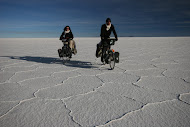Shores of Lago General Carrera, Aysen region. We left the Rio Baker canyon and passed the quiet little port of Puerto Bertrand, and we rode along the blue waters of Lago General Carrera. The lake was huge: it is the second largest lake in Latin America after Lake Titicaca. It is confined at the bottom of a valley surrounded by high mountains, some of which proudly exhibit a shiny snow cover. The waters of the lake seemt quiet and imperturbable, just little waves and jumping trouts were distinguishable. The water flows to the west in the Rio Baker, which flows into the Pacific Ocean at Tortel.
That day, we were lucky to enjoy a nice weather. Indeed, two days earlier, a rainstorm had hit the region, making our progress rather uncomfortable and wetting much of our equipment. But that day, the sun played with the clouds and illuminated parts of the surface of the waters. The lake was bounded by vertiginous cliffs falling in the waters.

 While pedaling, Caroline pointed out across the lake a horizontal terrain that contrasted with the mountains. Intrigued, we continued our journey in search of other similar areas. A few kilometers later, we found these areas on our side of the lake, close to the road. These plateaus were bounded by steep slopes. By approaching these plateaus, we realized that they were made of sediments, whereas all the surrounding mountains were made of metamorphic rocks. Moreover, we noted that these plateaus exhibited very similar altitudes.
While pedaling, Caroline pointed out across the lake a horizontal terrain that contrasted with the mountains. Intrigued, we continued our journey in search of other similar areas. A few kilometers later, we found these areas on our side of the lake, close to the road. These plateaus were bounded by steep slopes. By approaching these plateaus, we realized that they were made of sediments, whereas all the surrounding mountains were made of metamorphic rocks. Moreover, we noted that these plateaus exhibited very similar altitudes.
Along the road, it was possible to observe the sediments. They were quite sandy, light in color. Locally, we even saw the base of the sediments: the basal formations were deposited directly in contact upon metamorphic transformed and distorted rocks. The nearly horizontal sediments contrasted with the complex structure of the metamorphic rocks, and it was impossible to draw a continuous contact between them. This type of relationship is called an uncomformity. The fact that the sediments were uncomformable upon the metamorphic rocks indicated that there was a long time lap between the formation of the metamorphic rocks and the deposition of the sediments. The uncomformity indicated that the sediments were much more recent. However, this observation did not bring us any information on the origin of the sediments.


 The answer has been given by another lake, in which flowed a river: the Lago Verde near Villa Cerro Castillo. By flowing into the lake, the river deposited sediments that formed a delta, whose surface was almost horizontal and at the same level as the lake. By analogy, we concluded that the plateaus along the Lago General Carrera were former river deltas deposited in the lake. However, given that the plateaus were 100 to 200 meters higher than the present level of the lake, we inferred that the lake level was higher at the time of the deposition of the deltas. Therefore, much of the region was covered by water. But what was the origin of such variation?
The answer has been given by another lake, in which flowed a river: the Lago Verde near Villa Cerro Castillo. By flowing into the lake, the river deposited sediments that formed a delta, whose surface was almost horizontal and at the same level as the lake. By analogy, we concluded that the plateaus along the Lago General Carrera were former river deltas deposited in the lake. However, given that the plateaus were 100 to 200 meters higher than the present level of the lake, we inferred that the lake level was higher at the time of the deposition of the deltas. Therefore, much of the region was covered by water. But what was the origin of such variation?
It was in Coyhaique, at the Centro de Investigacion en los ecosystemas de la Patagonia (CIEP), that we found an explanation. We met Fabien Bourlon, a geologist at the CIEP, who has worked in collaboration with glaciologists of the Institut de Recherche pour le Développement (IRD). The IRD researchers showed that the Campos de Hielo Norte and Sur were connected into a huge single mass of ice during the last glacial period. This meant that the region where the river baker flows was covered with ice, meaning that the waters of Lago General Carrera were blocked by the ice, which acted as natural dam. The waters of the lake were retained and the lake level was higher that the current level. When the ice melted, the water could flow freely into the Pacific Ocean, and the lake level was lowered to the current level.

